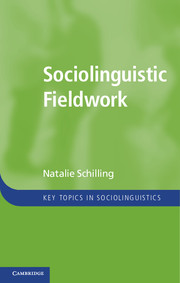3 - Data-collection methods
Published online by Cambridge University Press: 05 April 2013
Summary
In this chapter we cover a range of data-collection methods and instruments, from surveys conducted via questionnaires to sociolinguistic interviews to ethnographic participant-observation. In addition to discussing methods for obtaining data on variable language production, we discuss techniques for obtaining data on perception from within a sociolinguistic framework, including issues related to listeners’ identification of features, varieties, and speakers, as well as listener attitudes toward those who use particular features, varieties, and codes. In each case, we discuss both designing and implementing the various techniques, as well as the advantages, disadvantages, and purposes of each. At issue throughout is the question of “authenticity,” and we consider whether it is possible or even desirable to seek to remove researcher effects, in an effort to overcome Labov’s observer’s paradox: “To obtain the data that is most important for linguistic theory, we have to observe how people speak when they are not being observed” (1972a: 113). This chapter concludes with the recommendation that, wherever possible, researchers should seek to use a variety of data-collection methods in each of their studies since, as Labov so aptly put it in the earliest days of variationist sociolinguistics, we most closely approach sociolinguistic truth “by convergence of several kinds of data with complementary sources of error” (Labov 1972a: 97).
Method of administration: Face-to-face or long distance
The earliest dialect studies were conducted via survey questionnaires designed to elicit information on a range of language forms – lexical, phonological, and grammatical. A few early studies employed postal questionnaires, including the first dialect geographic study, conducted in Germany by Wenker, beginning in 1876. However, researchers soon decided that it would be advantageous on a number of levels to send out trained fieldworkers to administer questionnaires in person, and until recent decades, most sociolinguistic and dialectological studies that included a survey component relied on face-to-face rather than long-distance methods. Face-to-face surveys allow more control over who the respondents are, since we cannot know from long-distance surveys whether claimed demographic and other characteristics (e.g. attitudes) are accurate. In addition, administering surveys in person allows us to record responses ourselves (through on-the-spot phonetic transcription or audio recording), to record variable as well as categorical usages (since a single respondent may give more than one response to an elicitation in person but probably not on paper), and to provide and request clarification. In addition, because in-person surveys are usually administered orally, respondents may be more relaxed than when filling out a written form and so produce more naturalistic data.
- Type
- Chapter
- Information
- Sociolinguistic Fieldwork , pp. 66 - 133Publisher: Cambridge University PressPrint publication year: 2013

